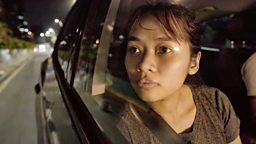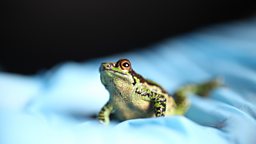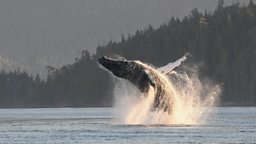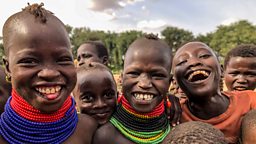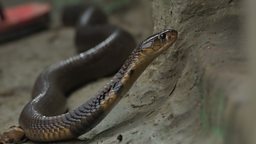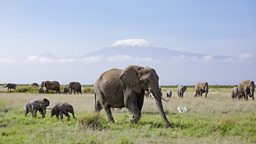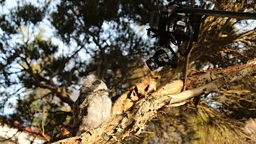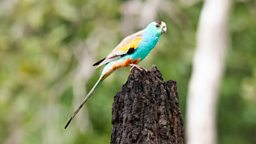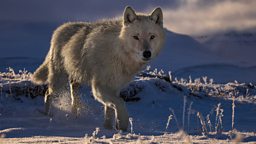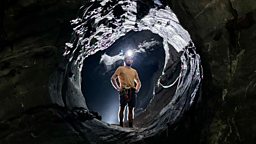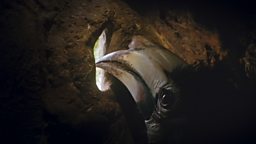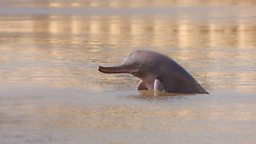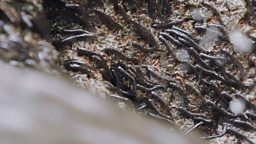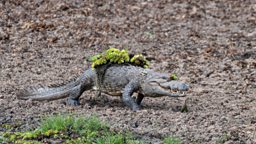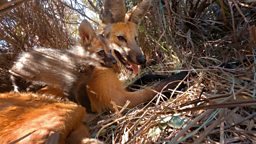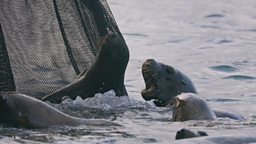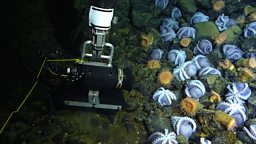Q & A on filming chimpanzees living near people in Uganda
With Abigail Lees, director for Forests
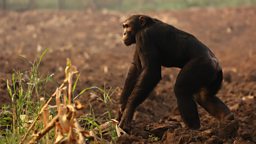
Could you briefly describe where the chimpanzees live β are there many houses, fields with crops, forests, etc?
A group of roughly 21 individual chimps live in a small forest patch surrounded by villages, agricultural farms, and gardens. There are only a few fruiting trees in the forest, so to survive the chimps leave the forest behind to seek food in the human world. The villagers grow small-scale crops in their fields and gardens - sugar cane, coffee, corn, cassava, and banana. Near the houses they have jackfruit and mango. Jackfruit is a year-round resource, whereas mangos are seasonal.
A community project, founded by scientist Matthew McLennan works with the local community to improve the livelihood and wellbeing of the citizens of these villages as well as the chimps.
Could you describe the role of the project?
Overall, the project exists to help local households conserve the forest. The forest acts as a buffer between the people and chimps.
The project also installs water pumps close to the houses, so villagers don't have to fetch water from the forest stream which reduces encounters with the chimps.
They provide free seedlings to residents. These include native seedlings to encourage reforestation, but also cash crops like coffee, which is not eaten by the chimps.
For families who choose to conserve their forest patch, the project pays for their children’s school fees, alleviating the need to chop down trees to make ends meet.

What was it like to film a natural history sequence on private land?
We had been talking to the landowners for two years before we came to film. The residents were very welcoming when we finally got to meet.
We got to know quite a few people during the 35 days we were in the field. It was really fascinating to hear stories of their interactions with the chimps over the years. Three neighbours – Bonnie, Lillian and Antonio – have pet dogs. All of their dogs know the chimps well and are very relaxed around them. We have seen videos of the dogs playing tag with the chimps in what looks like a fun game.

How did the chimp group react to you following them?
Every chimpanzee has a different personality. Some are very inquisitive, and others will try and get out of your line of sight and not want to be seen. In the beginning they found our presence in the forest a little more suspicious than out in the fields or near the houses. This makes sense because they are used to people being in human areas. In the forest, we were going into their space. In the village, they were coming into ours.
When in the forest, the chimp monitors Tom Sabiiti and John-Mary Baruzaliire, were always at our side. They’ve been monitoring these chimps for 15 years and 4 years respectively. The chimps are calm when they see Tom and John-Mary. If you are with them, you will slowly gain the chimp’s trust and they’ll get to know you. If you are not with the monitors, then the chimps are sometimes unsure about your intentions, and either run away or display – waving their arms and making a lot of noise to make it clear they are unconfortable - in which case we would immediately back away.
It is a wonderful feeling to be recognised by a chimp. You can see the recollection on their face.
We all had a particular affinity to an individual. Mine was Jack. A (subjectively!) good-looking male chimp who seemed to pose for the cameras whenever they were pointed at him. Cameraman Mitch Buckley enjoyed watching young Merrick, a bit of a mischief-maker who had some brilliant facial expressions.
Leila and Gift, a mother and son duo, was cameraman Sam Lewis’ favourite to watch. They were always goofing around. Mum would blow raspberries on her son’s belly or push him over when he was eating in a joking way. It was sweet.
Were they easy or difficult to find and film?
The chimps were surprisingly easy to film in a human environment. But they're not easy to catch up with. We tried to anticipate them. We’d try and get ahead of them, but often we’d get it wrong, and the chimps would be headed in a completely different direction. There was a lot of running around fruitlessly, a lot of energy wasted, a lot of frustration. But ultimately, I think that’s why it’s fun.
I like the unpredictability, and it’s good to be put in our place sometimes. The moments when things don't go our way are really humbling. They made the moments where we did get in sync with the chimps that much more special.
We relied very heavily on the expertise of the chimp monitors to find the chimps at the beginning of each day and to anticipate what the chimps would do. The drone was also a very useful tool. From the air, we often found the chimps kilometres away when we thought they were all sleeping quietly in dense bush next to us!
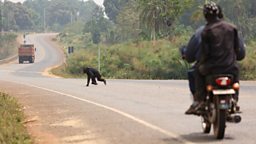
What was your first encounter with the chimpanzees?
My first encounter with the chimps was on our very first day of filming. They crossed the road within an hour of us being there. Not the natural setting I was hoping for my first encounter, but very much the story we came to tell.
It was surprising to see these apes – our closest living ancestor – look directly into the eyes of vehicle drivers as they made their way across a busy road.
How did you go about filming the chimps?
Ronan Donovan and Sam Lewis, who were on the long lens cameras, filmed the chimps using zoom lenses, so we could film them at a respectable distance. The camera, lenses and tripod were heavy to lug around in the uneven terrain of the small but dense forest patch, and the sloping farmland.
We also had a small drone, operated by Mitch Buckley - which allowed us to spot the chimps when they were out in the open.
Every day we’d find the chimps with the help of the chimp monitors and then follow them all day. We needed to gain their trust. Over several weeks, as the chimps got know us, and we got know the chimps, they let us into their world. From then on, it got much easier to film them, understand their routines and predict where they were going. This enabled us to film them feeding from human crops, getting close to houses and humans, and crossing the busy road.
How did the chimpanzees behave when helping themselves to crops? Did you feel they were aware that they were doing something a bit βnaughtyβ?
The chimps would go very quiet when about to take some crops. They’d enter a certain stealth mode. They seem to be aware of the dangers involved when operating in a human environment.
Once fed, however, it was a different story. The males could be loud, and display, and sometimes chase livestock.
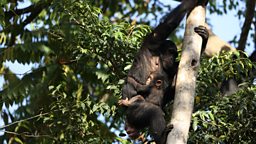
Were there any signs of young chimps learning new behaviours?
Lillian Tinkasiimire - a villager and neighbour to the chimps - thinks the chimps learnt how to eat jackfruit from people. You can see the chimps sniffing and testing the fruit for ripeness by prodding at it, just like what people do before harvesting it from the tree.
Chimps learn about what they can and can’t eat, what’s edible and what’s poisonous, from other chimps. Females are the ones to migrate from one group to another, so often females will introduce her new group to foods they may have never considered before. For example, the most recent female to migrate here (Kaije), has taught the rest of the group to eat peas and maize. This wasn't at all on their menu before she arrived.
When the chimpanzees approached a road, how do they behave? Did you feel they were aware of the dangers of traffic?
The alpha male’s mother died when he was young. She was hit by a car. Many chimps, if only from this experience, understand that traffic is dangerous.
Females and their young are much more cautious about crossing the road. They wait until there is a lull in the traffic and listen out for passing cars while hidden in the undergrowth. They know when it is safe to cross. There are speed bumps that have recently been put up to try and slow the traffic down. The females will only cross within the speed bumps.
The adult males, however, can be more reckless. I had to hold my breathe whenever young adult male chimp Gerald crossed the road. His road sense and timing were not great.
Were any of the chimpanzees visibly more aware of their chimp-human encounters than others? If so, in what way?
The females are much more wary of humans. It’s because they have their children to protect, so it makes sense that the females don't go as close to the houses as the adult males or take as many risks.
On the other hand, there are some chimps that are hyper-curious towards humans. Merrick, a subadult male, would often observe us. Araali, an adult male, was very curious when Ronan our cameraman filmed from a tree platform. He was at the bottom of the tree looking at Ronan’s bags and rope equipment for about 10 minutes. He looked at the rope and then back up at Ronan and down again at the rope bag. Perhaps he was trying to piece it together in his head.
Did you get a sense of what it was like to live alongside chimps from the people you met?
I’ll never know what it feels like to live alongside chimpanzees. I can only imagine. Chimpanzees are big and strong, and it is important to keep a respectful distance. But sometimes this is not possible with the chimps having to come outside the forest to find food. Human-wildlife conflict is prevalent in many countries across the world, and Uganda is no exception. There have been tragic incidents on both sides. It is more important than ever that forests are preserved across the world. The benefits of forests are wide ranging, but they also provide a home for many animals and plants, and can act as a buffer between humans and potentially dangerous wildlife.
The community feels all sorts of ways to their chimp neighbours, as is to be expected.
Some smile at the chimps and like to observe them. Others completely ignore the chimps and go about their day. Some shoo them onwards if the chimps are in their way or are about to eat their crops.
There is one lady of around 80 years old who sits and watches the chimps as they eat jackfruit next to her house. One evening she was making her dinner at an outside fire when they walked calmly past within centimetres of her. She stopped to watch them for a while. It was a beautiful scene. She’s known these chimps a long time.
What have you learnt from filming this sequence?
In a densely populated world, the key to preserving our precious biodiversity- including our dwindling large mammal population- is to put local community involvement at the centre of animal protection efforts.
This small village in Uganda is a real-world example of what is possible for conservation projects across the world.
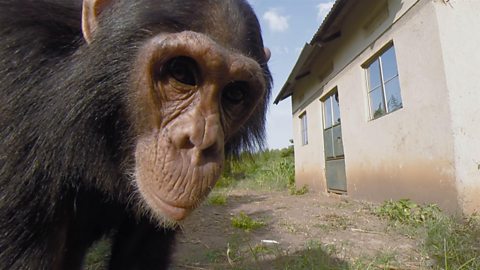
Learning to live alongside humans
Sir David looks at how the lives of chimps have been forced to change over the years.
